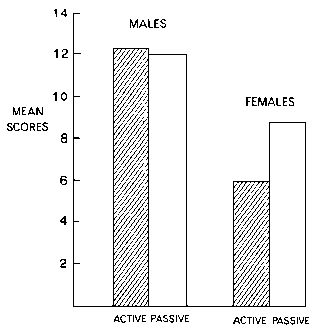
|
The Psychology of SexGlenn Wilson on Sexual Fantasies |
Consider the kinds of things that people report thinking about in their fantasies. This is more relevant to the sexual nature of men and women than comparisons of actual sexual behaviour, because fantasies are less constrained by partner preferences and social expectations. In 1987 I reported a survey in which large numbers of men and women were asked to describe in written, narrative form details of their favourite sexual fantasy. Since they were invited to do this anonymously there was little likelihood of conscious inhibition of responses.
When a content analysis of these self-reported fantasies was conducted (Table; columns total more than 100 because categories are not mutually exclusive, from Wilson, 1987a) it became clear that the typical fantasies of men and women were quite different. By far the most common element in male fantasies was group sex or sex with two other women; for example, ‘being tied to a bed with six or more naked women licking, kissing and fellating me.’ Thirty-one per cent of men included elements of group sex in their fantasies; the equivalent figure for women was only 15 per cent (Wilson, 1987a).
| Table Main elements of anonymously reported sexual fantasies (in percentages) | ||
| Fantasies | Men
(N = 291) |
Women
(N = 409) |
| Group sex | 31 | 15 |
| Voyeuristic/fetishistic | 18 | 7 |
| Steady partner incorporated | 14 | 21 |
| Identified people (other than partner) | 8 | 8 |
| Setting romantic/exotic | 4 | 15 |
| Rape/force | 4 | 13 |
| Sado-masochism | 7 | 7 |
| None | 5 | 12 |
| Everything | 3 | 0 |
| No answer | 21 | 19 |
The second most common theme in the male fantasies could be described as visual or voyeuristic, referring to clothing such as black stockings and suspenders, sexy underwear, leather, or nurses’ uniforms; for example, ‘A sixteen-year-old virgin dressed in a short-skirted school uniform and who wears a hairband all the time.’ Eighteen per cent of men had fetishistic elements like this in their favourite fantasy, but very few women did.
Other primarily male elements, perhaps related to the visual emphasis, were details of anatomy, reference to the age or race of the partner, and description of the sexual activity that was engaged in. Only very occasionally would women refer to anonymous physical characteristics such as the size of the man’s penis, the hairiness of his chest or his ethnic origins.
The most common element in female fantasies was inclusion of the husband or current loved partner (21 per cent). Only 14 per cent of males admitted their wives or current partners into their favourite fantasies. The second typically female characteristic was reference to exotic, romantic settings such as islands, beaches, forests, fields, flowers, waterfalls, moonlight, space and heaven (15 per cent); for example, ‘My man making love to me on a quiet beach in the moonlight with the waves lapping over us.’ The partner was usually present in these settings, and several women mentioned freedom from distraction, often from children or telephone, as an important aspect. Only 4 per cent of male fantasies included romantic settings such as this.
Another common female element was that of rape or force (13 per cent), although very often this meant being raped by the husband, partner or somebody already desired; for instance, being ‘raped by somebody I love.’ A much smaller proportion of men (4 per cent) said they would like to be raped by women, and a few fantasized being totally submissive to a female partner.
Although some people might think that women are more reticent with respect to their sex lives, there was no gender difference in willingness to answer this question about sex fantasies. It appeared as part of a larger questionnaire with no compulsion to complete all items. Twenty-one per cent of men left the question blank, compared with 19 per cent of women. However, more than twice as many women as men (12 per cent compared with 5 per cent) stated that they had no sexual fantasies; for example, ‘I don’t need fantasies because I am perfectly happy with my man and my sex life.’ Three per cent of men, but no women, claimed to fantasize about ‘everything.’
If sexual fantasies were scored for ‘masculinity-femininity’ in the manner that Eysenck scored sexual attitudes and preferences, a similar pattern of overlapping curves would be obtained. The fantasies of men and women have some things in common, but there also tend to be clear differences.
Many other differences between men and women in sexual fantasy patterns can be detected. If fantasies are classified into those that are ‘active’ (taking the initiative in some sexual activity) and those that are ‘passive’ (having something done to oneself) it becomes clear that men are much more likely to have active fantasies overall (Figure; Comparison of men and women on active and passive fantasy scores, from Wilson and Lang, 1981); men also report slightly more passive fantasies than women. Nevertheless, the ratio of active to passive fantasies is much higher for men than for women (Wilson and Lang, 1981).

There is an interesting difference in the connections between fantasy and reality. Those women who report exploratory fantasies seem to have no difficulty in translating their fantasy into actual behaviour. The correlation between fantasy and activity is very high (Wilson, 1978). The men are not so lucky; those who fantasize about having a lot of different partners are no more successful with women than those men who are less variety-orientated in their fantasies. Supply and demand in the sexual market-place works in such a way that for women an activity is little sooner desired than done, whereas men often have to settle for pornography and masturbation as outlets for their redundant libido.
Another striking difference between the fantasy life of men and women concerned their connections with sexual satisfaction . Generally speaking, those men who reported a great deal of sex fantasy had no partners or were in some sense sexually unfulfilled. Women who engaged in a great deal of fantasy were usually also having an active and satisfying sex life with a loved partner. Thus it seems that men’s fantasies often signify sexual frustration, while women’s fantasies are awakened or liberated by sexual activity.
Glenn Wilson, The Great Sex Divide, pp. 10-14. Peter Owen (London) 1989; Scott-Townsend (Washington D.C.) 1992.